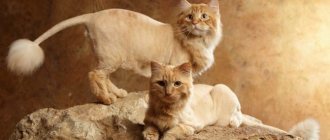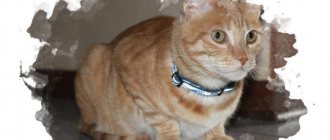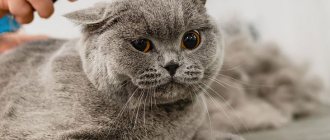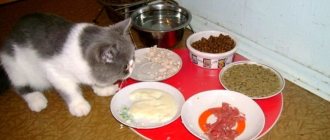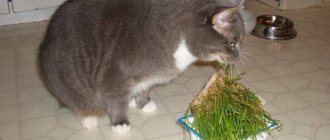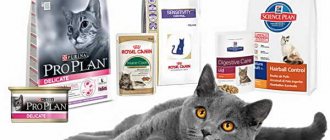Update date: 02/14/2021 14:36:52 11730 Share:
Author of the article: Astafieva Ekaterina Alekseevna
*Review of the best according to the editors of simplerule.ru. About the selection criteria. This material is subjective in nature, does not constitute advertising and does not serve as a purchase guide. Before purchasing, consultation with a specialist is required.
Flea drops are insecticidal preparations designed to kill harmful parasites. Products can be purchased at specialized animal stores or veterinary pharmacies. When choosing flea drops for cats, pay attention to the composition, because all substances used to kill insects have approximately the same mechanism of action. To help consumers make the right choice, experts from the online magazine Simplerules conducted market analysis, comparative tests, and studied customer reviews. The information obtained during the test allowed us to compile a rating of the best flea drops, including 11 nominees.
Benefits of flea drops
As mentioned earlier, many people use the drip form of flea medications. At the same time, the following advantages stand out during the operation of the solution:
- Easy to apply - on the skin in the area of the shoulder blades and the back of the head;
- With the right choice - safety of use;
- The duration of the effect is from 1 to 3 months, depending on the animal and its living conditions;
- The ability not only to eliminate fleas, but also to prevent their new establishment for the duration of the composition;
- Large selection among manufacturers.
Naturally, it is important to select a product in accordance with the parameters of a particular animal. Breed or gender does not play a role here. It is important to buy a product in accordance with the age of the cat, as well as its weight. After all, an ordinary yard cat will weigh 3-5 kg, and a Maine Coon will weigh up to 17 kg. Therefore, this point should be clarified. Otherwise, an incorrect dosage will not bring benefit or even harm the pet.
What harm can fleas cause to a cat?
Fleas and ticks are blood-sucking insects that survive in the harshest conditions. They can live without food for one and a half months. Once on the body of a pet, they dig into the skin and begin to fill their stomach. In this case, the cat can lose quite a lot of blood. Ticks and fleas cause harm to a cat's health, which is expressed in the following:
- The bite sites are very itchy, the cat is constantly itching, causing wounds to itself. These wounds can easily become infected;
- Some time after infection, the cat begins to actively lose hair. This whole process can result in severe baldness;
- At the moment of a bite, toxic substances enter the cat’s bloodstream with the insect’s saliva, which can provoke a severe allergic reaction;
- Ticks and fleas become carriers of helminth eggs;
- Infection with parasites negatively affects the condition of the eyes, ears and nasopharynx. Chronic diseases, such as otitis media, often appear.
Fleas and ticks pose a particular danger to a kitten. Their exposure leads to anemia and rapid exhaustion. If help is not provided in a timely manner, the kitten may die.
By the way, you can learn all the intricacies of fighting fleas in kittens in the corresponding article: How to remove fleas from a kitten.
It is necessary to apply flea drops immediately after you notice signs of infestation. The sooner you start treatment, the greater the chance of successful treatment. Remember that it is not enough to treat the animal; you will also have to disinfect the room in which it lives.
Which substances can be used and which cannot?
Naturally, the drops contain compositions based on disinfectant components. Some of them are safe for cats, and some can even kill your pet. Safe ones include:
- Imidacporil;
- Finpronil;
- Silamectin.
But permethrin can cause mass poisoning, even if the animal is protected from licking the composition from its fur. It penetrates the systemic bloodstream and can cause serious disruptions in the functioning of internal organs. In particularly severe cases of intoxication, the animal may die.
Advantages and disadvantages of drugs in the form of drops
Modern stores offer a wide range of products aimed at combating skin parasites. You can choose from spray, shampoo, collar or drops. The latter are the most popular. This is due to their following advantages:
- Flea drops for cats are applied to the withers. This place is inaccessible to the animal, so it does not have the opportunity to lick the drug;
- The drugs have a gentle composition. They cannot cause any harm to the pet, while effectively dealing with parasites;
- The drops are easy to use. Their application time does not exceed one minute;
- Such drugs begin to act immediately after application. After just 15 minutes, the insects die;
- You will have to use the drops no more than once every 2 months;
- Such funds are relatively cheap;
- The drug is complex, that is, it acts not only against fleas, but also against ticks, helminths, lice eaters and other parasites.
Despite all their advantages, anti-flea drops for cats also have some disadvantages. In some cases, their use may provoke an allergic reaction. Some medications may be contraindicated in kittens and pregnant cats.
Interesting. In the Middle Ages, fleas were fought with the help of special devices - flea traps. This is a small box with slots, inside of which there is a sticky bait (honey, resin, etc.). Crawling inside the flea trap, the flea stuck and could no longer get out.
TOP 5 best flea drops for cats
If we consider the positive effect of the composition, then it is achieved in most cases. But if we consider difficult situations, when the animal has suffered greatly from parasites or has other types of problems, then we distinguish:
- Advantage. Consists of imidacloprid. Available commercially and can even be used on kittens. Effective against fleas and ticks, but only for 1 month.
- Stronghold. Based on silamectin. It can be used from the age of 6 weeks. This composition helps against both external and internal parasites. valid for about 1 month.
- Frontline. Contains finpronil. This remedy can be used from 8 weeks of age. Its validity period is 2 months.
- Inspector Total K is represented by the composition fipronil and moxidectin. These drugs provide a lasting effect of up to 2 months, as well as rapid elimination of parasitic insects. Used in cats 1-4 kg from 8 weeks of age. Helps eliminate worm eggs on wool, mites, and blood-sucking insects. These drops are odorless and have no side effects on the animal.
- RolfСlub 3D. The drug is based on pyriproxyfen, fipronil, etofenprox. It is used in animals up to 4 kg, and can be used from 12 weeks of age. Effective against fleas, ticks, lice and flying insects. Valid for about a month.
These drugs are effective if used according to the instructions. Their composition is safe for relatively healthy animals.
Expert opinion
Danilova Maria Alekseevna
Therapist, dentist, ophthalmologist, surgeon, express tests, ratologist, groomer.
It is important to understand that in seriously ill animals, remedies of this kind are used only as a last resort. The same applies to the use of anthelmintics and flea drops.
What are there
Blood-sucking parasites cause itching and transmit dangerous diseases (encephalitis, piroplasmosis). Preventive protection and treatment are carried out with drugs contained in different forms:
- Shampoos – remove insects, not suitable for long-term use.
- Collars - contain natural essential oils (repel), chemicals (gradually released, accumulate on the surface).
- Drops - applied to hard-to-reach places (withers, between the shoulder blades, back of the head), are not absorbed into the blood, accumulate in the sebaceous glands, and paralyze.
- Tablets - have an attractive smell, taste, substances are absorbed and distributed throughout the body.
- Spray - sprayed over the entire surface, it takes time for the fur to dry, it can scare away and paralyze.
- Injections, injections - used in case of severe infection, lack of effect after other types.
For lactating and pregnant animals, products based on herbs and essential oils are suitable.
Sprays are convenient for treating rooms, bedding, and kennels.
Rules for applying drops to a cat
In order for the composition to act as effectively as possible, it is important to follow the rules of application. The process itself is quite simple. It is necessary to secure the animal so that it does not twitch during the process. After this, the fur on the neck and between the shoulder blades is pulled apart. The composition drips onto the skin. Ideally, it is better to hold the animal in your hands for a while and calm it down. Next, the process lies in the details:
- If you plan to wash the animal before the effect of the composition expires, you need to stop using it before bathing or carry out the hygiene procedure earlier.
- If the cat has a very thick undercoat and it is very difficult to reach the skin, some owners trim an inconspicuous area of fur with the utmost care. This will make processing much easier.
- If the animal was bathed with flea shampoo or treated with another composition, then it is necessary to maintain the time between medications. The duration of the break depends on the specific form of insecticide.
- In addition to the animal, its bed, the place where it lives, and toys should be treated with flea products. Afterwards, objects and surfaces are thoroughly washed or washed.
- If additional exposure is required, you should consult a veterinarian, as too frequent use of insecticides can lead to poisoning of the cat.
- After applying the product, it is important to ensure that the animal does not shake itself off for some time and does not try to paw into the treatment area. The latter is dangerous in the context of licking.
- If it is not possible to prevent licking, then you should put protective material in the form of a blanket or collar on the cat.
The composition is considered safe immediately after drying. But in no case can you “adjust” the absorption process with the same hairdryer. It pays to be patient here.
How to choose
The selection of a quality product depends on the physical characteristics of the pet, the chemical characteristics of the active ingredients, and the presence of allergic reactions. Main steps:
- veterinarian consultation;
- choose the type of product (drops, collar, tablets);
- quantity, effect of components (additionally against ticks, helminths);
- determine the dose (depending on age, weight);
- study the manufacturer’s information (features of administration, side effects);
- duration of protection, effectiveness;
- quality certificate.
During treatment and prevention, it is necessary to simultaneously treat rooms, bedding, sleeping places, and kennels.
Additional preventive protection - folk remedies: bathing with tar soap, essential oils and decoctions (cloves, tansy, orange, wormwood, rosemary).
At what age are flea drops used?
Almost all drugs are intended for cats aged 2-3 months, but there are also safe drops that can be used for treatment earlier.
Some cat drops suitable for pregnant and lactating cats are contraindicated for kittens. Therefore, to avoid harming the animal, read the package insert.
Frequency of treatment of kittens
To prevent the appearance of fleas, prevention is required once a quarter. If a kitten is infested with fleas, it should be treated with antiparasitic medication immediately.
Effective drops work instantly, killing blood-sucking insects from the first minutes of contact with the pet’s body.
Rules for handling pets
Before using drops, you must read the instructions for their use. The instructions contain information about indications, contraindications and precautions.
It is important to apply the drops not to the fur, but to dry skin without damage. Application area: near the back of the head (withers).
Standard rules for handling domestic cats:
- When applying the medicine, do not allow it to come into contact with the skin.
- After treating the animal, even if the drug was in ampoules, wash your hands thoroughly.
- In order to achieve maximum effect and be able to quickly identify adverse reactions, the kitten should be supervised for the first 2-3 hours.
- If your pet must be left alone, put a veterinary cone on him.
Methods of applying the drug.
Precautionary measures
The peak of toxicity, when the drops act, occurs on the first day. Therefore, it is forbidden to pet the animal and allow it near children.
If a treated cat accidentally comes into contact with human skin, rinse the area with plenty of water. Avoid contact with mucous membranes and affected areas of the skin.
General rules of use
Before using deworming medications for kittens and adult cats, you need to weigh your pet and choose the optimal dosage. Drops should be applied to dry and clean skin of the withers or the area between the shoulder blades. The animal will not be able to lick the substance from these places.
After calming and stroking the cat, you need to carefully smooth its fur so that the drug is absorbed into the dermis. After the procedure, the animal must be held for a short time, otherwise it will shake off the medication from its body. The drops have a thick and greasy texture, so during treatment, cat hair in the treatment areas will look unattractive. The average frequency of treatment is 1-2 times a day.
For preventive purposes, the procedure is recommended to be performed every 3 months.
Medicines against worms are toxic, so they should be used taking into account the following recommendations:
- Avoid contact of the medication with the skin and mucous membranes;
- It is forbidden to drip the drug onto areas that a cat or cat can reach with its tongue;
- if several pets are being treated simultaneously, they must be kept separately for 24 hours;
- After the procedure, you should not pet your pet for 1-2 days;
- during the first 2 days after treatment, you should not bathe the animal;
- If there are children in the family, then they need to be protected from interaction with a cat treated with an anthelmintic drug for at least 1 day.
Video “How to give a cat anti-flea medication?”
In the video you can see how to apply flea treatment correctly and where.
Was this article helpful?
Thank you for your opinion!
The article was useful. Please share the information with your friends.
Yes
No
X
Please write what is wrong and leave recommendations on the article
Cancel reply
Rate the benefit of the article: Rate the author ( 4 votes, average: 3.75 out of 5)
Discuss the article:
Basic rules for using drops
Flea drops for cats will only work effectively if they are used correctly. In this case, the following rules must be observed:
- Using drops at home is extremely simple. It is enough to spread the fur on your pet’s withers, drop a couple of drops and rub it with your fingers so that the liquid does not spread. The exact amount of product to be used is indicated in the instructions.
- After application, the product quickly begins to act. The cat should not be combed or washed for several days.
- Some medications are recommended to be applied to points along the entire length of the spine. This way the effect of the product will be stronger. But at the same time you will have to monitor whether the cat licks the product.
- Cases where flea drops on the withers for cats do not help are rare. This is only possible if, after applying them, the animal gets caught in heavy rain and the drug is washed off.
- When applying drops, you must be careful not to accidentally get them into your pet's eyes or nose. If this happens, rinse thoroughly with plenty of running water.
- If the drops are licked off, there is no need to worry. The amount of active substance is so small that it cannot harm the pet. But if you treated kittens for ticks and fleas, and the cat licked them, a negative reaction from her body is possible. Because of this, many drugs are prohibited for use on kittens under two months of age.
- You should only purchase anti-flea drops for cats in large, trusted stores. This is the only way you can be sure of their quality and safety.
Article on the topic: How to apply flea drops to a cat?
Folk remedies
How to kill fleas and worms at home using traditional methods? If the owners do not want to resort to medications, then time-tested treatment methods will come to their aid:
- Hellebore water. An alcoholic infusion of hellebore is a plant that is a natural insecticide. The wool is sprayed with a spray bottle until the insects are completely destroyed. Dead parasites are combed out with a fine comb.
- Wormwood decoction. The specific smell of wormwood repels most insects - ticks, fleas, lice eaters. For the decoction, take dry wormwood, eucalyptus, tansy in equal proportions, pour boiling water over it and cook over low heat for 20 minutes. When the liquid has cooled, bathe the cat in it, making sure that the broth does not get on the face.
- Decoction of geranium and lavender leaves. It will help rid the animal of both insects and worms. 2 tbsp. l. wormwood and tansy are poured with 250 ml of boiling water. The cat is given 3 tbsp. l. infusion for 3 days.
- Garlic. The pungent garlic smell repels parasites. A few cloves of garlic are crushed and poured with 3 cups of boiling water. The liquid is infused for 12 hours and then dripped onto the animal’s withers. From there, the cat will not be able to lick off the poisonous infusion.
- Tar soap. This remedy is good because it not only destroys insects, but also promotes the healing of wounds, ulcers, and irritation after bites. Whisk the soap into a thick foam and wash the cat. The procedure should be repeated until the ectoparasites are completely eliminated.
- Pumpkin seeds. One of the most popular folk methods of getting rid of worms. 300 g of seeds are crushed to a paste, mixed with 50 ml of water and 15 g of honey. The resulting mixture is given to the cat, and after half an hour an enema is given. Another recipe with pumpkin seeds: 5 g of crushed pumpkin seeds are mixed with 5 g of pork fat. The cat is fed this mixture on an empty stomach for 5 days.
Comparison table
| Manufacturer | Animal weight, kg | Volume, ml | Age | Price, rub |
| Hartz | 6-10 | 1,3 | from 3 months | 300 |
| Astrapharm BlochNet max | 4-8 | 1 | from 6 months | 180 |
| Zoetis (Pfizer) | 2,5-4 | 0,25 | from 3 months | 450 |
| Inspector Mini | 2 | 0,4 | from 6 weeks | 323 |
| Beaphar | 2-6 | 400 | from 12 weeks | 580 |
| Celandine | 2-5 | 100 | from 10 weeks | 430 |
| Bars Forte (AVZ) | 2,5-5 | 100 | from 3 months | 500 |
| Agrovet protection Lugovoy | 2,5 | 270 | from 6 weeks | 150 |
| Doctor ZOO | 2,5-6 | 250 | from 10 weeks | 250 |
| Dana Apicenna | 2-4 | 145 | from 12 weeks | 530 |
Contraindications to the use of deworming drops on the withers for cats
Most anthelmintic drugs have similar contraindications. They should not be used without consulting a veterinarian in the following cases:
- skin infections or lesions;
- weakened immunity as a result of operations or chronic diseases;
- acute infections not associated with the presence of endoparasites in the animal’s body;
- severe exhaustion;
- pathologies of the liver and urinary system;
- pregnancy and lactation. In this case, deworming is carried out under the strict supervision of a veterinarian.
- severe infestation with worms. Treatment must be carried out according to an individual treatment regimen.
- The animal is less than 2 months old. You should either wait or choose another form, such as a suspension.
What substances are used in flea treatments?
To combat insects, products based on organic or synthesized insecticides are used. The task of these substances is to destroy the parasite, which they successfully do by acting at the cellular level. Despite the fact that most insecticides are quite toxic, in the quantities in which they are applied to the skin of an animal, they are safe for pets.
The most common insecticides that act as active ingredients in preparations:
- Permethrin. An insecticide and acaricide belonging to the group of pyrethrins - natural toxins contained in the flowers of plants of the aster family. It is a neurotoxic poison, disrupts the ion permeability of sodium channels and inhibits the process of polarization of the membrane of nerve cells.
- Pyriproxyfen. Analogue of insect growth hormone. Blocks embryogenesis, metamorphosis and reproduction of sexually mature individuals. Under the influence of the drug, the larvae die, and the adults become sterile.
- Fipronil. Insecticide from the phenylpyrazoles group. In the insect's body, it binds to chloride channels and blocks GABA receptors. This leads to hyperexcitation, paralysis and death of the parasite.
Frontline
This product is available in tubes of various dosages. The use of this drug is approved for animals of different ages, both kittens and adult cats. However, it is not recommended for use on sick and weakened animals. The use of Frontline drops is effective in the fight against fleas, worms, and ear mites. When applied, the coat color of some animals may change, so it is not advisable to use it before an exhibition.
When choosing a product for your pet and before using it, you need to study what the instructions guarantee and how the drug will work. You can also study reviews from people who have already assessed the effect of specific drops on their pet. But first, you should still visit the veterinarian and show him your pet. The specialist will make an appointment and select the most suitable treatment for the animal.
Many cat owners leave grateful and positive reviews about medications that help rid their animals of parasites. There are thousands of them on the Internet, and people not only write words of gratitude, but also attach photos of their healthy and happy pets.

